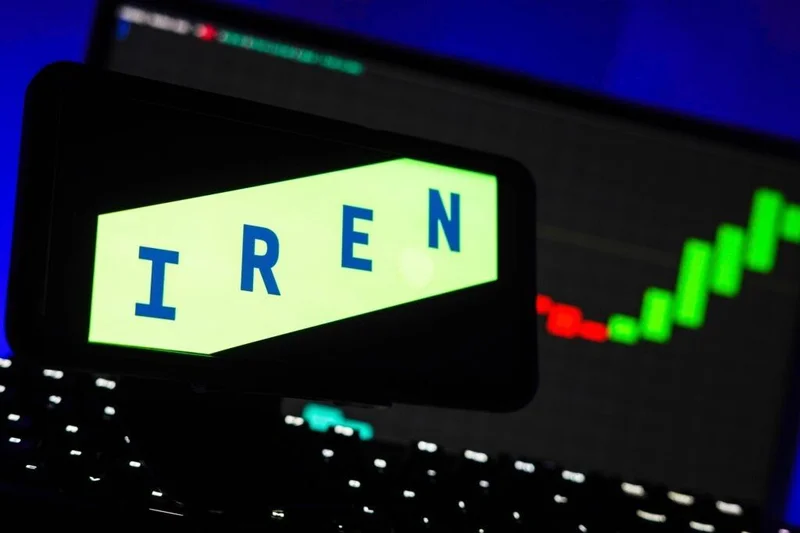A stock chart that goes vertical is a rare and often unsettling sight. In the case of IREN Limited (NASDAQ: IREN), the ascent has been less of a climb and more of a launch. The company’s stock has surged roughly 500%—to be more exact, 488% year-to-date as of recent reports—transforming it from a niche Bitcoin miner into a nearly $13 billion entity in a matter of months. A $10,000 investment a year ago would now be worth north of $50,000.
This is not a story of gradual growth; it's a narrative of violent repricing. The market has fundamentally re-evaluated what IREN is and what it could become. The question for any rational observer is whether this repricing is based on a sound quantitative thesis or if it’s an outlier fueled by the market’s insatiable appetite for anything attached to the two hottest letters in finance: A and I. The company has effectively strapped a second engine to its fuselage while in mid-flight. We need to analyze if the airframe can handle the stress.
The Dual-Engine Transformation
At its core, IREN’s story was once straightforward. Formerly Iris Energy, it was a Bitcoin miner with a specific, marketable angle: it used 100% renewable energy. Operating data centers in Canada and Texas, it leveraged cheap hydro and wind power to mine Bitcoin with high margins (often exceeding 70%), an appealing proposition for ESG-conscious investors. As Bitcoin rallied above $120,000 in 2025, this business alone was performing exceptionally well, expanding its hashrate fivefold to a massive 50 EH/s. That made it one of the largest miners on the network, a significant achievement.
But starting in 2024, management executed a pivot so aggressive it bordered on a complete identity shift. They began converting their data centers, built for crypto ASICs, into facilities for high-performance computing (HPC) for the artificial intelligence industry. This wasn't a minor side project. IREN committed $674 million to purchase approximately 23,000 high-end GPUs from NVIDIA and AMD. To put that in perspective, the company's entire revenue for fiscal year 2025 was $501 million. This is an all-in bet.
The strategy is to become what the industry is calling an "AI neocloud"—an independent provider of the raw computing power that AI firms desperately need. The company now presents itself as a hybrid, a unique entity with two powerful, synergistic engines: a profitable, large-scale Bitcoin mining operation and a high-growth AI cloud services division. Both leverage the same core assets: vast tracts of land with access to nearly 3 gigawatts of cheap, green power. This pivot has been perfectly timed to coincide with an explosion in AI demand, exemplified by OpenAI's recent multi-year deal to purchase a staggering 6 gigawatts' worth of AMD's AI chips. That single deal signaled to the market that the demand for compute is, for the foreseeable future, functionally limitless.
IREN’s transformation is like taking a powerful, reliable diesel truck—great for hauling freight—and bolting on a jet engine. The raw power is undeniable, and the potential speed is exhilarating. But it also introduces immense complexity and new points of failure. Can the two systems run in harmony, or will one cannibalize the resources of the other? And is the market correctly pricing the potential of this new hybrid vehicle, or is it just mesmerized by the flame coming out of the new engine?

A Valuation Under the Microscope
When a company’s valuation detaches from its historical fundamentals, you have to scrutinize the forward-looking assumptions. IREN’s market capitalization has ballooned to over $12 billion, yet it posted its first-ever annual profit in FY2025 at just $87 million. This gives it a trailing price-to-earnings (P/E) ratio well over 100. For comparison, established miners trade at P/E multiples in the high teens, and even tech giants like Microsoft are in the 30-40 range. IREN is being priced not as a miner, or even a cloud company, but as a hyper-growth startup on the verge of world domination.
The entire bull case now hinges on one key projection: management’s target of achieving over $500 million in annualized AI cloud revenue by the first quarter of 2026. Let’s deconstruct that number. With 23,000 GPUs, this implies each GPU must generate approximately $21,700 in annual revenue. The company has stated its recent contracts allow for a hardware cost payback in about two years, which seems to support this math. They’ve already secured contracts for 11,000 of their GPUs, representing about $225 million in annual revenue.
And this is the part of the report that I find genuinely puzzling. While securing initial customers is a strong proof of concept, the AI cloud space is rapidly becoming crowded. Other miners are attempting the same pivot, and specialized players like CoreWeave are scaling aggressively. Can IREN maintain this premium pricing as thousands, or even hundreds of thousands, of new GPUs come online across the industry in the next 18 months? What happens to that two-year payback model if rental prices for GPU compute fall by 20% or 30%? The current valuation seems to assume not only that IREN will hit its $500 million target, but that this is just the beginning of a much larger, highly profitable ramp.
Wall Street is sharply divided, which is usually a sign of extreme uncertainty. On one end, you have Roth MKM with an $82 price target, a bullish stance supported by arguments that IREN’s Stock Rally Is Just Getting Started (NASDAQ:IREN). On the other, JPMorgan has slapped an "Underweight" rating on the stock with a $24 target, arguing that the share price already reflects a scenario of near-perfect execution. That discrepancy is a chasm. It tells you that the models analysts are using are incredibly sensitive to just a few key variables (GPU rental rates, Bitcoin price, and deployment timelines). A small change in any of these assumptions can swing the valuation by billions of dollars.
The company is effectively asking investors to price it on revenues that don't exist yet, from a business line that was negligible a year ago, in an industry whose competitive landscape is changing by the week. It’s a compelling story, but the numbers require a significant leap of faith.
The Price of Perfection
My analysis suggests that IREN's current stock price is not just optimistic; it's priced for perfection. It assumes flawless execution in deploying tens of thousands of GPUs on an aggressive timeline. It assumes the company can secure long-term, high-margin contracts for all that capacity in an increasingly competitive market. And it assumes its legacy Bitcoin mining business will continue to thrive in a notoriously volatile crypto market, especially post-halving. The probability of all three of these conditions being met without a single significant hiccup is, statistically speaking, low. The market has priced the 99th percentile outcome as the base case. That is not a sound foundation for a long-term investment, but it is the perfect recipe for the volatility we’re seeing today.

